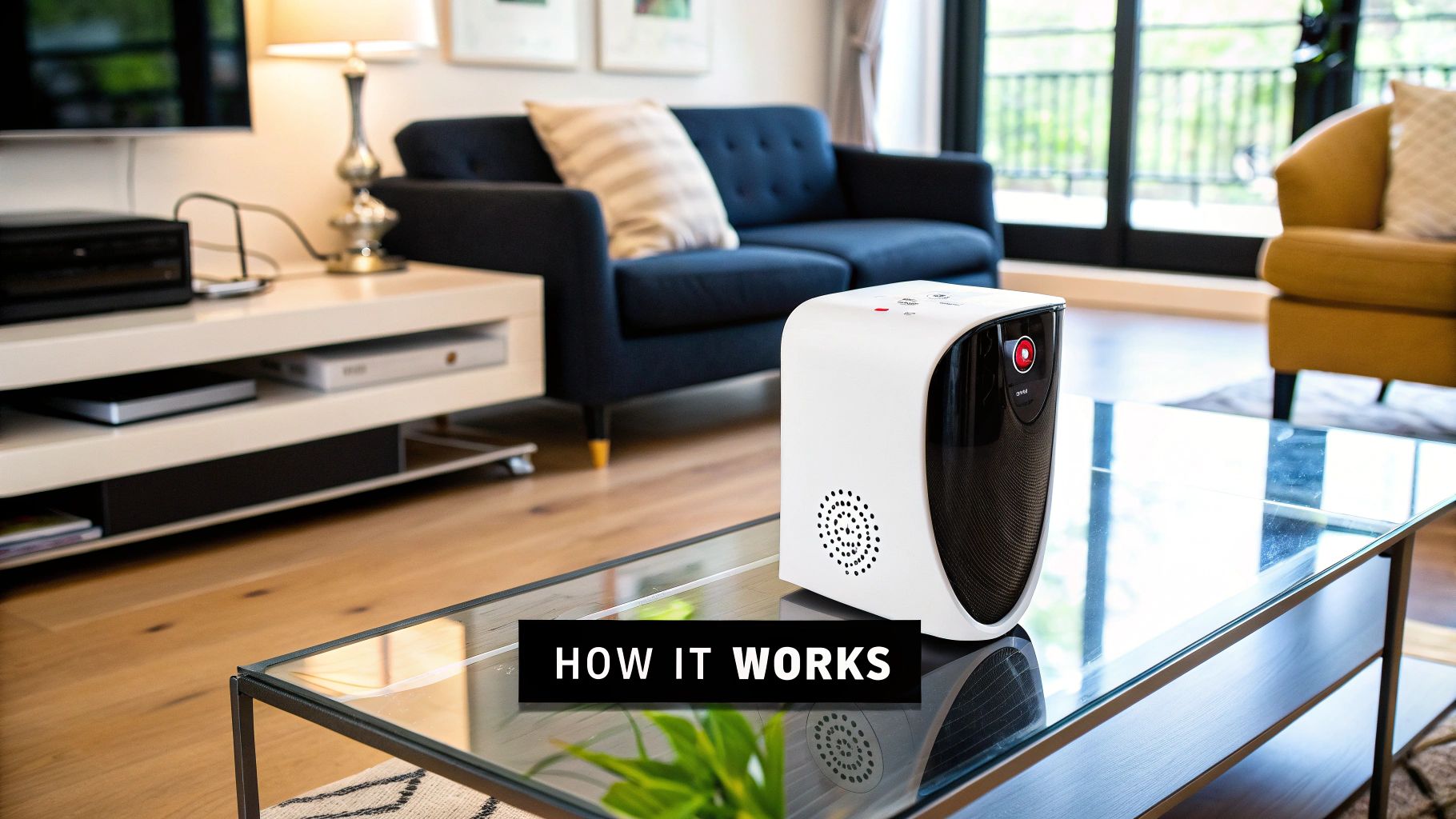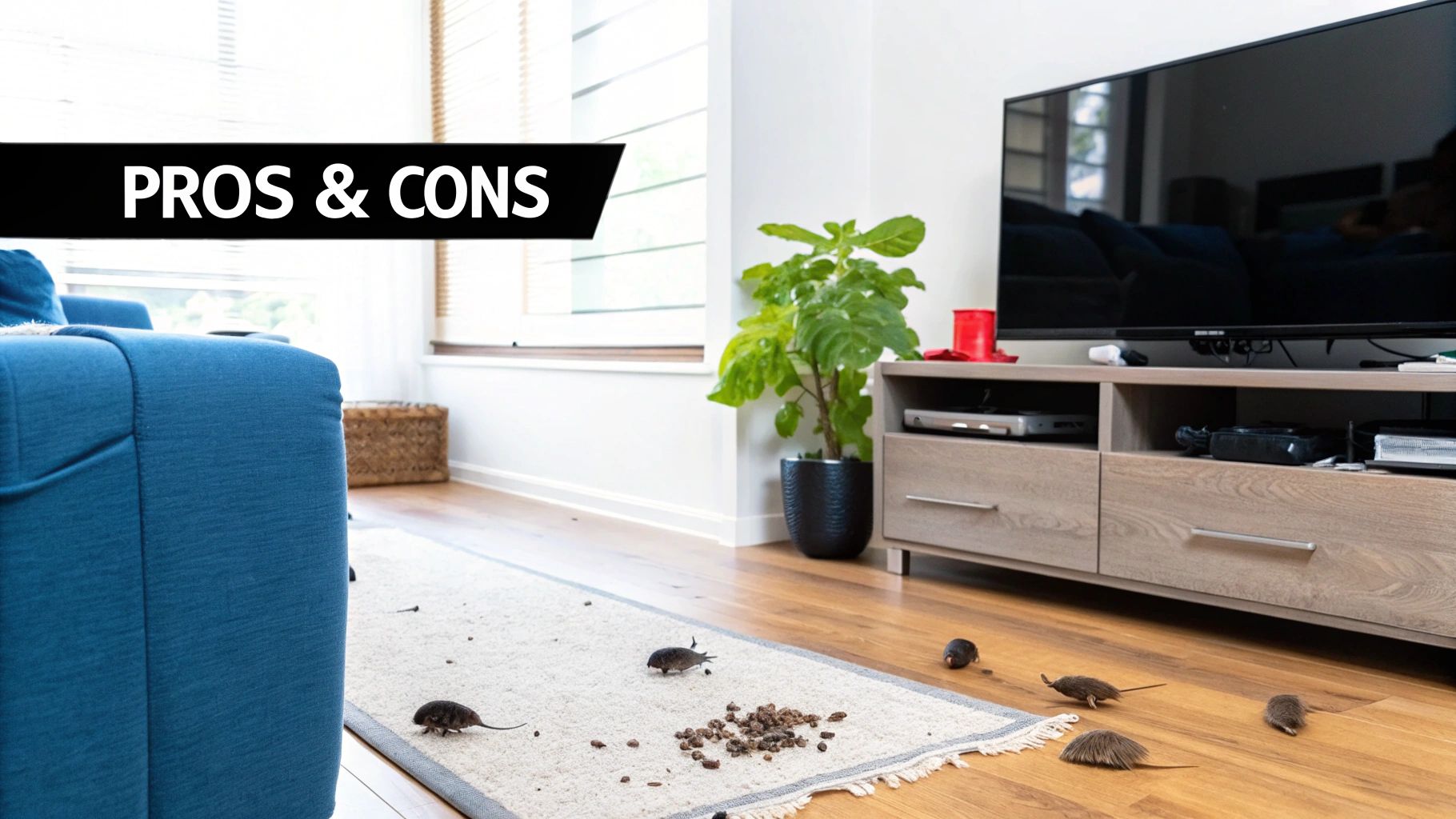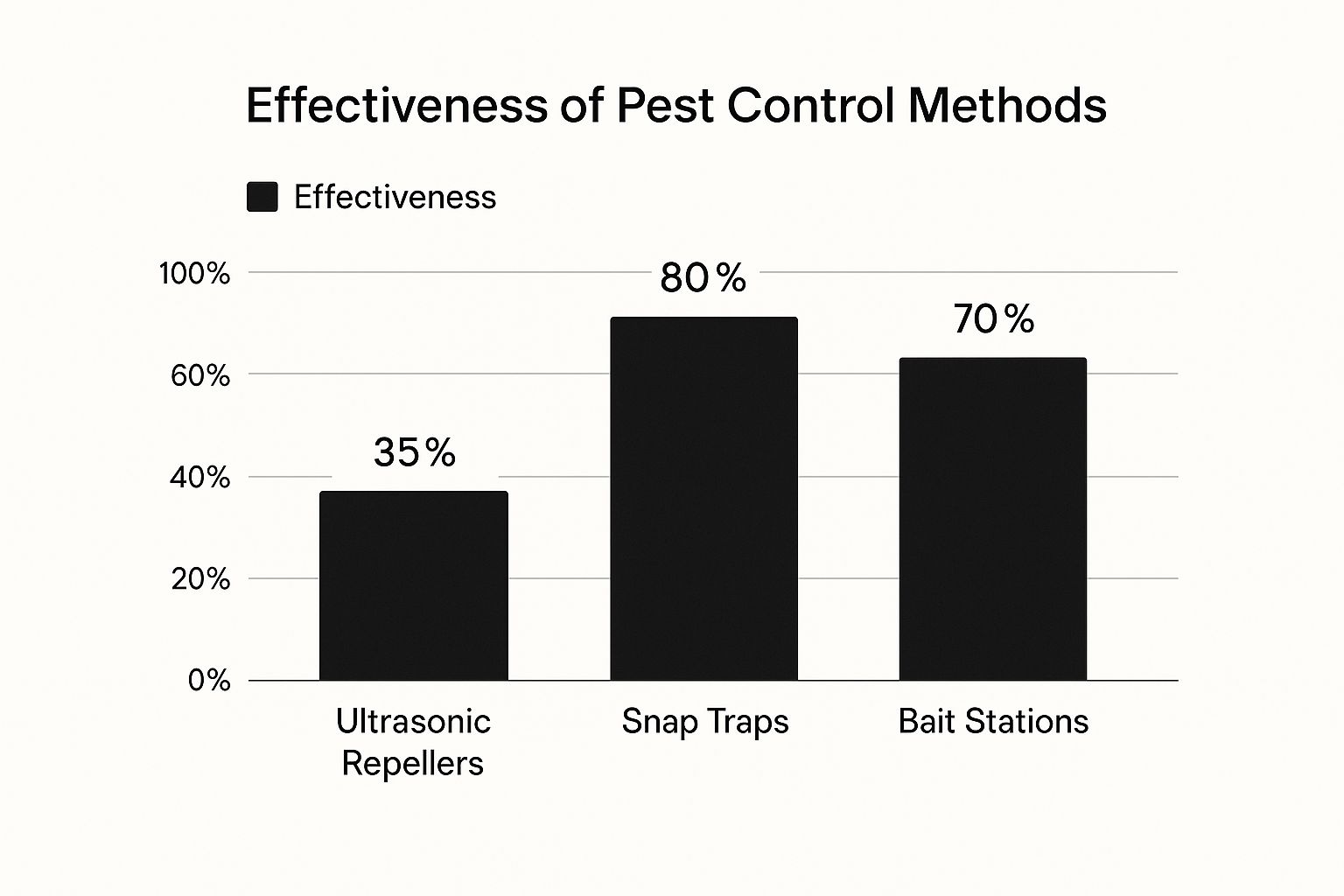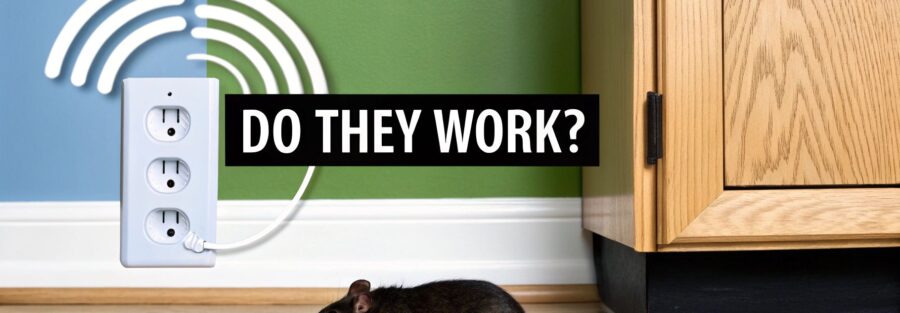Right, let's get straight to the point. Do ultrasonic mouse repellers actually work? The short answer from seasoned pest control professionals like us is a resounding no. They simply aren't a reliable or long-term fix for a rodent problem.
While the idea of a silent, plug-in-and-forget solution is incredibly appealing, the real-world evidence just doesn't stack up. Time and time again, we see clients who have wasted money on these gadgets only to find their mouse infestation is worse than ever.
The Real Story on Ultrasonic Repellers
So, let's break down exactly why these popular devices fail to deliver on their promises. We’ll look at the science behind how sound travels, the remarkable adaptability of mice, and the simple physical limitations that make these units pretty much useless in the average UK home.
Manufacturers will tell you their devices create an unbearable "acoustic environment" that drives mice away. The reality, however, is far less impressive.
Why They Don't Work: The Two Biggest Flaws
When you get down to it, there are two massive problems that stop these repellers from being effective: habituation and physical barriers.
First off, mice are incredibly resilient creatures. They might be startled by the strange new noise for a little while, but they quickly learn that it poses no physical threat. Once they realise it can't actually harm them, they simply get used to it and carry on as before. It's a basic survival instinct.
Even more importantly, high-frequency sound waves are surprisingly weak. They can't travel through solid objects, which creates a huge issue in any furnished room.
“Laboratory tests have shown that these devices do not control insects or rodents in a home environment.”
— Federal Trade Commission
Think of it like this: a single sofa, a thick pair of curtains, or even an internal wall will cast a complete "sound shadow." This creates a safe zone where mice are totally unaffected by the noise. They can happily nest, feed, and breed just metres away from the device, completely undisturbed.
To help you see the full picture, we've put together a quick summary of the key factors that make these devices a poor investment for anyone serious about getting rid of mice.
Ultrasonic Repellers At a Glance: Key Considerations
This table breaks down the main reasons why ultrasonic repellers consistently fail to provide a lasting solution for rodent control.
| Factor | Summary of Impact |
|---|---|
| Habituation | Mice quickly get used to the sound, realising it poses no real danger and eventually ignoring it entirely. |
| Sound Shadows | High-frequency sound cannot pass through walls or furniture, creating safe pockets where rodents can thrive. |
| Limited Range | The effective range is often much smaller than advertised and is confined to a single, unobstructed room. |
| No Root Cause Solution | Repellers do nothing to address how mice are getting in, failing to seal the entry points that are the real problem. |
Ultimately, these devices offer a false sense of security. They might make you feel like you're taking action, but they don't tackle the fundamental reasons you have a pest problem in the first place.
How Ultrasonic Repellers Are Meant to Work
The idea behind ultrasonic mouse repellers is genuinely clever. Imagine a fire alarm that screeches constantly, creating an unbearable racket that only mice and other pests can hear. That’s the principle these devices are built on. They plug into a standard wall socket and emit high-frequency sound waves, typically between 20 and 60 kilohertz (kHz), which is far above what a human ear can pick up.

The goal is to create an acoustically hostile environment. This constant, high-pitched noise is designed to be intensely irritating for rodents. In theory, it disrupts their most fundamental behaviours, making it hard for them to communicate, navigate, find food, or even rest peacefully. The overwhelming auditory stress is meant to be so unpleasant that they simply pack up and find a quieter home.
The Intended Biological Effect
From a biological standpoint, the sound is supposed to trigger a natural flight response in mice. Manufacturers claim the ultrasonic waves tap into a mouse's innate aversion to specific frequencies, causing serious distress and confusion. This constant sonic assault is meant to overload their senses, making your home feel unsafe and unwelcoming.
The theory is that the high-frequency sound creates a non-lethal but highly effective barrier, encouraging rodents to voluntarily leave without you needing traps or poisons.
However, putting this technology into practice in the real world comes with some major hurdles. For these devices to work, the sound has to do more than just be annoying—it must reach every single corner where mice might be hiding. And that’s a critical point where theory often crashes into reality.
These devices have been sold in the UK for about 20 years now as a humane, chemical-free alternative. But even after all that time, solid scientific evidence proving they work is still thin on the ground. UK wildlife organisations frequently point out the lack of rigorous research to back up the strong claims made by manufacturers. If you'd like to read more on the subject of rodent control and its impact on wildlife, the Bat Conservation Trust is an excellent resource.
The effectiveness of these sound waves is also at the mercy of your home’s layout. Any solid object, from a sofa to an internal wall, can block or absorb the signal. This means the sound can’t get into the very places it's needed most, like inside wall cavities or behind kitchen appliances where mice love to nest. It's a fundamental limitation that makes physical barriers, such as installing professional-grade mesh air brick covers, a much more reliable way to stop rodents from getting in.
Why Science Says They Fall Short
Moving from the optimistic theory to what actually happens in a real home, this is where the promise of ultrasonic repellers starts to fall apart. While the idea of a silent, irritating noise driving mice away sounds perfect, science points to two critical flaws that make these devices pretty useless in most UK homes.

The first major issue is habituation. Let's be clear: mice are incredibly adaptable survivors. They're driven by powerful instincts to find food, water, and shelter. After an initial period of alarm from the strange, high-pitched sound, they quickly realise it isn't actually connected to a physical threat.
Once they figure that out, they simply learn to ignore it and get on with their business. This isn’t just a theory; it’s a well-documented behaviour. The noise becomes nothing more than background ambience, like traffic humming outside a window, and the mice go right back to their normal routines.
The Problem of Sound Shadows
The second, and arguably bigger, problem is the fragile nature of high-frequency sound waves. Unlike the lower-frequency sounds we hear every day, ultrasonic waves are pathetic at travelling. They can’t penetrate solid objects like walls, doors, or even soft furnishings like sofas and thick curtains.
This creates countless ‘sound shadows’ throughout a room. These are essentially dead zones where the ultrasonic waves can't reach, leaving mice completely undisturbed. A mouse could be nesting safely behind your kitchen kickboards or under a bookcase—often just a few feet from the device—and never even hear it.
A single device plugged into one socket can only affect the open, unobstructed area of that room. It offers zero protection for the rest of your home, especially the wall cavities and hidden spaces where mice actually live and travel.
To have any chance of being effective, you’d need to plug a device into every single area, including inside cupboards and behind furniture, which is completely impractical. This is why focusing on physical barriers is so much more important. If you want to understand the common routes they take, our guide explains how mice get into your house in detail.
Real-World Experiences from UK Homeowners
While the science and lab tests offer one side of the story, the real question is always: does it actually work in a proper home? When it comes to ultrasonic mouse repellers, the feedback we hear from UK homeowners and fellow pest controllers tells a frustratingly consistent tale.
It’s a story we’ve heard countless times.

The experience usually starts with a glimmer of hope. A homeowner, fed up with scurrying sounds, plugs in a new device. For a day or two, things might go quiet. The mice, initially startled by this strange new noise, seem to disappear.
But that hope almost never lasts. Before you know it, usually within a week or two, the familiar scratching and rustling sounds are back. The mice are back to business as usual. This isn't just a theory; it's the reality played out in kitchens, lofts, and garages across the country.
The Problem of Habituation in Action
Here’s the thing: mice are survivors. They're driven by the powerful, primal need for food, water, and shelter. Once they figure out that the high-pitched noise isn't actually a threat—that it can't physically harm them—they simply learn to ignore it. The so-called "hostile acoustic environment" just becomes irritating background noise.
The anecdotal evidence from the field is pretty damning:
- Nesting Neighbours: We've been called to jobs where pest controllers have found mouse nests built right next to an active ultrasonic repeller. The mice clearly weren't bothered in the slightest.
- Caught on Camera: Home security footage often shows mice running straight past these devices without even flinching.
- The Unimpressed Rodent: In some cases, mice have even been spotted sniffing around the repellers themselves, showing more curiosity than fear.
Reports from pest control specialists in the UK overwhelmingly show that ultrasonic repellers fail to provide any consistent, long-term results. Rodents like mice and rats quickly habituate to the sounds, undermining any initial deterrent effect.
This pattern is well-documented. A typical scenario, whether in London or South Yorkshire, involves that brief drop in activity, followed by a full-blown return of the infestation within a month. If you want to dive deeper, you can find more expert insights on why these devices fail in real-world settings.
These real-world stories aren't just stories; they're tangible proof that backs up the scientific consensus. They show you exactly what to expect if you rely on one of these gadgets to fix a genuine mouse problem.
Effective Mouse Control Methods That Actually Work
So, if ultrasonic gadgets don't solve your mouse problem, what does? The answer isn’t some magic bullet, but a strategy that we professionals live by: Integrated Pest Management (IPM).
IPM isn't about finding a single device to scare mice away. It’s a common-sense approach that tackles the root causes of the infestation—figuring out why mice have decided your home is a great place to live and then systematically taking that invitation away.
This is about moving beyond gimmicks and focusing on what will get rid of mice for good. Think of it like a three-pronged attack: building a fortress, cutting off their food supply, and then dealing with any stragglers who are already inside.
The Three Pillars of Real Mouse Control
A truly effective pest control plan is proactive, not reactive. It’s built on a foundation of exclusion, good sanitation, and, only when necessary, targeted population control.
- Seal Entry Points: This is the single most important step. A mouse can squeeze through a hole the size of a pen lid, so you have to be meticulous. Find and seal every last gap.
- Improve Sanitation: Mice are opportunists, always on the lookout for an easy meal. Make your home less appealing by keeping kitchens spotless, storing food in airtight containers, and fixing any leaky pipes.
- Strategic Population Reduction: Once you’ve blocked off their entrance and removed their food and water, you can start dealing with the mice currently calling your house their home.
The infographic below really highlights why ultrasonic repellers fall so short when compared to proven, traditional methods.

As you can see, methods like snap traps and bait stations are far more effective because they directly address the existing mouse population, rather than just trying to annoy them into leaving.
Choosing the Right Tools for the Job
When it’s time to reduce the mouse numbers in your home, you’ve got several reliable options. What you choose often comes down to personal preference and the scale of the problem.
Let's break down the most common and effective methods.
Mouse Control Methods Comparison
This table compares different rodent control methods, looking at how well they work, how humane they are, and the effort required from you.
| Method | Effectiveness | Humaneness | Our Recommendation |
|---|---|---|---|
| Snap Traps | High. When set correctly, they are a fast and definitive solution. | Moderate. Provides a quick end if the trap functions properly. | A solid, reliable choice for quickly reducing a mouse population. Best for homeowners comfortable with lethal methods. |
| Bait Stations | Very High. Can eliminate an entire colony by targeting the source. | Low. Poison causes a slow, painful death. | The most powerful option for severe infestations, but best left to professionals to ensure safety for pets and children. |
| Live-Capture Traps | Moderate. Effective for catching individual mice, but requires effort. | High. Allows for release, but this must be done correctly. | A good non-lethal option, but you must release the mouse at least 2 miles away or it will find its way back. |
| Ultrasonic Repellers | Very Low. Mice quickly get used to the sound. | High. Does not physically harm the pests. | Not recommended. Scientific evidence shows these are not a reliable long-term solution for an active infestation. |
Ultimately, choosing the right tool is just one part of the puzzle.
Classic snap traps are brutally effective and give a quick result. A dab of peanut butter or chocolate spread is all you need. Place them along walls where you’ve seen signs of activity, and they can make a serious dent in an infestation overnight.
If you’d rather not deal with that, humane live-capture traps are a great alternative. They let you catch the mice and release them elsewhere. Just remember, "elsewhere" needs to be at least two miles from your property, or you’re just giving them a scenic tour before they come right back.
Combining these proven tools with a solid plan for exclusion and sanitation is the only guaranteed way to reclaim your home from mice. If you’re dealing with a stubborn infestation and need a hand, our professional pest control services can give you the expertise you need to put these strategies into action and get lasting results.
Final Recommendations from Pest Control Experts
After looking at all the science and real-world feedback, what’s our final verdict? To put it plainly, do ultrasonic mouse repellers actually work? The answer from pest control experts across the UK is a clear and resounding no.
The promise of a simple, silent, and humane fix is certainly tempting. However, these gadgets consistently fail to deliver a reliable, long-term solution to a genuine mouse problem. The overwhelming evidence shows that mice just get used to the noise, and the sound waves themselves are far too weak to get through walls, furniture, or other common household objects.
Your Most Effective Action Plan
Instead of spending money on a device that offers little more than a false sense of security, we strongly recommend putting your time and resources into proven Integrated Pest Management (IPM) techniques. This is the professional strategy that tackles an infestation at its source and provides a solution that lasts.
The path to a rodent-free home isn’t built on gimmicks. It’s built on proactive, physical actions that don't just annoy mice—they completely remove their ability to get in and survive in your property.
Here’s our straightforward, expert-approved plan:
- Thoroughly Inspect Your Property: Walk the entire perimeter of your home and look for any potential entry points. Check for gaps around pipes, vents, air bricks, and beneath doors. Remember, a mouse can squeeze through a hole the size of a pen.
- Seal Every Single Gap: This is the most crucial step you can take. Use tough, durable materials like steel wool, caulk, or professional-grade mesh to block every single opening you find. This physically stops them from getting inside.
- Clean and Sanitise: Take away their reason for being there. Store all food in airtight containers, clean up crumbs and spills right away, and make sure pet food isn’t left out overnight.
- Use Effective Traps: For any mice already inside, use traditional snap traps or humane live-capture traps. Place them along walls and in areas where you’ve seen droppings or other signs of activity.
By focusing on exclusion and sanitation, you are not just treating the symptoms of a mouse problem—you are solving the root cause. This is the only way to ensure they don't come back.
Following these steps gives you a confident and effective plan built on strategies that actually work. It’s the direct path to reclaiming your home from unwanted pests.
Your Questions Answered
When you're looking for a simple fix for a pest problem, it's easy to be drawn in by gadgets like ultrasonic repellers. But do they actually work? It’s a question we get all the time from homeowners across the UK.
Here are the straightforward, no-nonsense answers to the most common questions we hear. We’ll cover everything from how they might affect your pets to why they are so popular despite being completely ineffective.
Will an Ultrasonic Repeller Bother My Dog or Cat?
For the most part, no. The sound frequencies these devices pump out are well above what dogs and cats can typically hear. This means they are very unlikely to be disturbed by the noise.
However, the story is completely different for smaller pets. Animals like hamsters, gerbils, guinea pigs, and rabbits have a much wider hearing range that often overlaps with the frequencies these repellers use. For them, the constant high-pitched noise can be incredibly stressful. If you keep these smaller animals, it's best to steer clear of these devices entirely.
Do Ultrasonic Repellers Work Through Walls?
This is a critical point, and the answer is a definitive no. The high-frequency sound waves from these devices are extremely weak and easily stopped by solid objects. They cannot travel through walls, doors, floors, or even dense furniture like a sofa or a set of drawers.
This physical limitation is one of the biggest reasons they fail. A single device can only affect the open, unobstructed air in one room, leaving countless ‘sound shadows’ where mice can live and travel completely undisturbed.
Think of it like a torch beam in a cluttered room—every object casts a shadow where the light can't reach. In the same way, these devices create safe zones all over your home where mice feel perfectly comfortable, completely defeating the purpose.
Is There Any Situation Where They Might Be Useful?
Their usefulness is incredibly limited, even in a best-case scenario. Some might suggest a device could cause a very brief, temporary disruption to a brand-new, minor infestation in a completely open and empty space, like a small, bare shed.
But even then, it’s not a reliable strategy. It is certainly not an effective solution for an established mouse problem, and it offers zero value as a long-term preventative measure in a typical home. Your time and money are far better spent on proven methods, like finding and sealing entry points and improving home sanitation.
Still struggling with a stubborn mouse problem? Don't rely on gadgets that don't deliver. The experts at Pest Predators Limited use evidence-based strategies to solve your pest issues for good. Visit us at https://www.pestpredatorslimited.co.uk to learn how our professional pest proofing and control services can secure your home.



